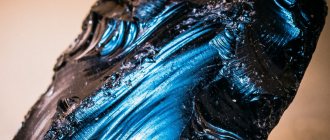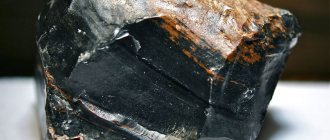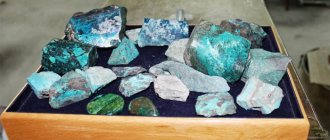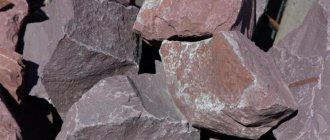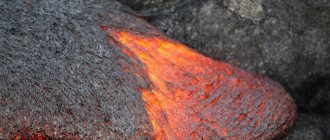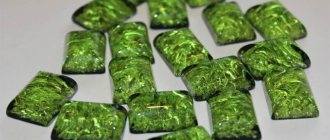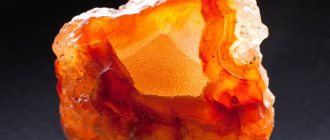| Category | Rocks |
| Title in English | Obsidian |
| Formula | SiO2 |
| Group | Acid rock group |
| Color | Black, Brown, Transparent |
| Stroke color | White |
| Shine | Glass |
| Transparency | Opaque, Translucent |
| singonia | Amorphous |
| Hardness | 5 — 6 |
| Cleavage | Absent |
| Density, g/cm³ | 2,5 — 2,6 |
| Kink | Large-shelled |
| origin of name | The name obsidian has two origins. According to the first, mirrors were made from this igneous rock, so the ancient Greek word οβσις was used for the name. It is translated into Russian as a spectacle. According to another version, the stone was named after the Roman Obsidia, who once brought the mineral from Ethiopia to Rome for the first time. The full name was Obsidianus lapis, which is translated from Latin as Obsidia stone. |
The mineral obsidian has been known to mankind for about 9,000 years. The mineral received its name in honor of the Roman Obsidius. Obsidian is found in lava that hardens after volcanic eruptions. And already in the Paleolithic, people could easily make a knife, ax or spear based on this stone. As stone processing technologies developed, obsidian became more and more famous. At the end of the 19th century, its popularity increased significantly due to its use in Faberge products. Now obsidian is widely used in jewelry and as an ornamental stone.
Obsidian deposits
The largest obsidian deposits are located in Ecuador, Mexico, Indonesia, Japan, Ethiopia, Peru, Germany, Turkey, Armenia, Iceland and the USA, wherever there are zones of volcanic activity in ancient or modern times. In Russia, obsidian deposits were found in Kamchatka, the Caucasus and Siberia. Iridescent obsidians are found in Nevada and the Hawaiian Islands.
History of obsidian
— Advertising —
For the first time, obsidian was brought from Ethiopia to Europe by a Roman named Obsidius, which was the reason for the appearance of this name for the stone. Obsidian was known by different names among different peoples. For example, in Transcaucasia, as “a fragment of Satan’s claws”, in America as “tears of the Apaches”. The Greek term "obsis" translates as "spectacle", and may also have had an influence on the formation of the mineral, as in ancient times it was used to make mirrors.
During the Stone Age, primitive people used obsidian in the manufacture of knives, arrowheads, and scrapers. They were sharper than metal ones and therefore popular. In Egypt, incense was stored in obsidian vessels to preserve its qualities. Writing utensils were also made from the stone, as it was believed that obsidian had a beneficial effect on the thought process of its owner. Residents of the Caucasus and India endowed obsidian with magical properties and used it as a ritual stone.
Obsidian gained popularity in jewelry at the end of the 19th century, when Carl Faberge began using it in this capacity.
Story
| Classic version Java Edition | |||||
| 0.26 SURVIVAL TEST 9 (October 24, 2009) | Obsidian added. | ||||
| It was mainly used to create black buildings or dark line pixel art. In Survival Test, obsidian destroyed very quickly and 1-2 cobblestones fell out of it. | |||||
| Indev version of Java Edition | |||||
| ? | Obsidian has been removed from the game. | ||||
| Infdev version of Java Edition | |||||
| ? | Obsidian has been returned to the game. | ||||
| Alpha Java Edition | |||||
| 1.2.0 | Added a portal to the Nether, which is created using obsidian. | ||||
| Java Edition Beta | |||||
| 1.8 | 1.8 Pre-release | Obsidian can be destroyed with an iron pickaxe, as before removal, or moved by an Ender. | |||
| Official release of Java Edition | |||||
| 1.0.0 | Beta 1.9 Prerelease 3 | Added an enchanting table that uses obsidian to craft. | |||
| Beta 1.9 Prerelease 6 | Obsidian mining time reduced from 15 to 2.5 seconds. | ||||
| Obsidian mining time increased from 2.5 to 10 seconds. | |||||
| 1.1 | Obsidian can be found in chests in NPC villages. | ||||
| 1.3.1 | 12w21a | Added an End chest that can be crafted using obsidian. | |||
| 1.4.2 | 12w36a | The lighthouse can now be crafted using obsidian. | |||
| 12w38a | Obsidian can now be destroyed by the Blue Wither Skull explosion. | ||||
| 1.8 | 14w30a | Obsidian can be found in chests in Nether Fortresses. | |||
| 1.9 | 15w31a | Obsidian is generated in the cities of the Edge. | |||
| 1.14 | 18w44a | Changed obsidian texture. | |||
| Alpha version of Pocket Edition | |||||
| 0.5.0 | Added Glowing Obsidian, which drops regular obsidian when mined. Regular obsidian has also been added; it is mined much faster - 3.5 seconds. | ||||
| Added a Nether Reactor that generates a “castle” of obsidian upon activation. | |||||
| 0.6.0 | The Nether reactor now generates "castles" from hellstone instead of obsidian. | ||||
| 0.12.1 | build 1 | A portal to the Nether has been added, which requires obsidian to create. | |||
| 0.13.0 | build 2 | Obsidian mining speed has been reduced - now it takes 9.5 seconds instead of 3.5, like on PC | |||
| Official release of Pocket Edition | |||||
| 1.0 | build 1 | Obsidian is now used when crafting Ender Chests. | |||
| 1.1 | build 1 | Obsidian is generated in forest mansions. | |||
| Legacy Console Edition | |||||
| TU1 | CU1 | 1.0 | Patch 1 | Obsidian added. | |
| New Nintendo 3DS Edition | |||||
| 0.1.0 | Obsidian added. | ||||
Physico-chemical characteristics of obsidian
Obsidian is a glassy rock of volcanic origin, which is why it is sometimes called volcanic glass.
Its formation occurs during the rapid cooling of lava, which spills onto the ground during a volcanic eruption. Obsidian is an amorphous stone. By chemical nature it is silicon oxide with admixtures of magnesium and iron oxides. — Advertising —
Obsidian is colored in shades of gray, brown, red and black. It has an amorphous system and a conchoidal fracture. The hardness of the stone is 5-6 on the Mohs scale. Specific gravity 2.3 g/cm3.
Varieties and colors of obsidian
Obsidian is a silicon oxide. Its reserves in the earth's crust are considered inexhaustible, since the rock will be formed as long as volcanoes exist and erupt. The second name of the mineral is volcanic glass.
Chemical and physical properties of obsidian (SiO2 + Fe3O4 + MgO):
- hardness – 5–6 Mohs points;
- density – 2.5 g/cm3;
- shine – glass;
- transparency – low (slight translucency is possible);
- cleavage – no;
- the fracture is large conchoidal.
Black obsidian is the most common, although specimens of other colors are often found. The black color is due to the presence of magnetite in the composition.
Color varieties of obsidian:
- Brown is a stone of harmony and self-improvement.
- Silver is an attribute of shamans and alchemists.
- Snowy is a common type with small light flecks of cristobalite resembling snowflakes.
- Rainbow is the rarest and most valuable species. The surface of the stone is iridescent, with red, green, and blue shades. And when cut, the mineral resembles a dark resin.
- Peanut - a stone the color of peanut husks with numerous black spots and specks.
- Green.
- Blue (California).
- Golden (Caucasian).
- Plum Shin is a purple colored stone with red and violet tints.
Types of obsidian
There are several subspecies of obsidian depending on color:
- “Peanut” or “snowy”, painted in gray-white color, and “snowflakes” seem to be scattered across its surface.
- Rainbow is distinguished by unique color tints that resemble oil drops. The most valuable and expensive subspecies.
- Red obsidian.
- Green obsidian.
- Blue-blue obsidian.
What is volcanic glass?
There are several types of volcanic glass:
- Resin stone (pechstein) , it also has options - diabase, liparite, phonolite stones. It can be black, brown (very light or dark), green, red-brown. The shine is greasy, resinous.
- Snow obsidian . Black in color with white spots of various shapes. The most interesting specimens are covered with snowflake-like spots. It is sometimes called "peanut obsidian".
- Rainbow obsidian . It is rare and therefore valuable. When cut, it often resembles a rainbow film of gasoline. Painted in blue, reddish, greenish colors and their shades.
We recommend: The beauty and power of RED AGATE
The stone looks very presentable. Impenetrable depth, shine, bright color attracts the eye.
The magical properties of obsidian
It is believed that obsidian contains the power of the Sun, Saturn and Uranus, and people have turned to its magical abilities since ancient times.
So, special balls for fortune tellers were made from it. As a protective amulet, obsidian keeps the owner from committing bad deeds and helps fight shortcomings. It protects from the evil eye and negative energy. The mineral gives composure, the ability to concentrate and focus on the most important, makes thoughts precise and sharp. For this reason, writing instruments are often made from it. In the Caucasus, obsidian was considered the patron saint of children, capable of protecting them from harm, the evil eye and damage.
Obsidian for men
Men prefer to wear brown volcanic stones. Obsidian makes a man confident and attractive in the eyes of the opposite sex. As a remedy, the stone helps representatives of the stronger sex fight pathologies of the urethra, prostate and other organs of the genitourinary system.
Obsidian is a talisman for men who travel frequently, go on business trips, or who have chosen a profession that involves risk and maximum concentration. It protects you from dangers along the way.
In the old days, sailors and travelers to unknown lands took it with them on the road. Today, obsidian is recommended as a travel talisman for machinists, pilots, and truck drivers.
Medicinal properties of obsidian
Traditional medicine uses obsidian to treat colds that appear during hypothermia.
It is also believed to have a positive effect on the gastrointestinal tract. Obsidian beads and rosaries normalize blood pressure. In general, obsidian is useful as a preventative. But wearing it all the time is not recommended.
Branches of application of obsidian
Obsidian fragments have sharp cutting edges, which is why ancient people began to use the mineral.
Scrapers, knives, spears, axes, arrowheads - all this was made on the basis of this mineral. Obsidian artifacts discovered in Mesopotamia date back about 9,000 years. Later, various jewelry and amulets, household items and ritual figurines began to be made from obsidian. The Aztecs and Ethiopians learned to make mirrors from it. Obsidian knives became objects of rituals. And, despite the fact that people learned to make such iron products, obsidian did not lose its leadership position.
Obsidian began to be widely used as a jewelry and ornamental stone in the 19th century. Carl Faberge was the first to draw attention to the interesting properties of the stone and its attractive appearance. Today, obsidian is in demand among other semi-precious stones for making watches, writing sets, fountains, animal figurines, beads, key rings, and rosaries.
The mineral has also found application in industry as an intumescent filler for lightweight concrete.
Obsidian. Stone and properties.
Obsidian.
Mineral Class: Volcanic Rock Chemical Formula: Fe3O4 Hardness: 5
The color of obsidian is usually dark - black, green, brown, brick-red, gray, the color is often spotted, streaky, banded.
Obsidian is formed by the interaction of volcanic lava with water. Lava often ends up in lakes or the ocean, where it quickly cools. As a result, glass structures are formed in the formed rock. Iron and magnesium give obsidian its dark green to black color.
Obsidian may include small air bubbles that form textures parallel to the direction of lava flow. These bubbles can lead to interesting effects such as:
- golden glow (Shimmering obsidian),
- silvery glow (Silver obsidian),
- rainbow multicolor glow (Rainbow obsidian). Occasionally, obsidians are found with iridescence in bluish-blue, green and reddish tones, sometimes combined iridescently in one piece.
- Inclusions of small, white, radially fused cristabolite crystals in black glass create the effect of snow flakes (Snow Obsidian). Snow obsidian is a black material with light gray inclusions that look like flowers or snowflakes.
The rounded secretions of obsidian are called Apache Tears.
Obsidian is one of the first stones known to man. Even in the Neolithic, it was used to make arrowheads and spears, scrapers and knives. The oldest obsidian finds are 9 thousand years old. A little later, primitive people learned to carve animal figures and jewelry from obsidian.
This is what the ancients believed: obsidian is a product of the underworld, which, however, did not stop them from making knives and arrowheads, and subsequently, various jewelry and decorative objects. Obsidian is not even a stone, but rather volcanic glass. This is lava that solidified so quickly that minerals did not even have time to form in it.
The Roman Obsius, who was the first to bring obsidian from Ethiopia, gave it his name, thereby perpetuating his memory. The earliest objects made of obsidian were discovered in Mesopotamia; their age exceeds nine thousand years.
It is believed that obsidian retains the energy of the volcano, and therefore it has been revered by all religions since ancient times and was used to make various religious attributes.
They say that obsidian is “the black hole inside us,” a powerful energetic that gives strength on a physical, rather than spiritual, level. At the same time, obsidian is used by lithotherapists to treat rheumatism and gout, diseases of the genitourinary system, as well as to cleanse the organs.
In Ancient Egypt, it was believed that incense vessels were stored better and longer in obsidian vessels - obsidian protected them from damage.
It is curious that, according to legend, the “product of the activity of the underworld” protects against the evil eye and damage, curses and other magic, from evil forces and unkind people. It protects on the road and restores peace of mind after unhappy love, and also protects against betrayal.
In the ancient civilizations of Central America, where they believed in corruption, the evil eye, and evil spirits, mirrors were made from obsidian. Such interior items were not only supposed to help a woman “put on a face” or a man to practice a manly smile, but also served as a kind of “cleansing” from magical evil influences - it was believed that a person looking into an obsidian mirror was automatically cleansed of all damage.
Tradition says that obsidian can protect against bad deeds (moreover, it simply makes it impossible to commit sins) and suppress aggressive energy, sharpen the sharpness of thought and relieve tension - such an interesting gift from the “underworld”. And at the same time, obsidian is a magical stone, and any magician should have it in his arsenal - to concentrate astral forces, to fight astral elemental spirits, and even to subjugate these spirits to himself. Obsidian was considered especially valuable for magicians because it is capable of not only opening a channel of clairvoyance and helping in meditation, protecting from evil and comprehending the essence of existence, but also does not allow one to leave the ground, connecting the magician with the planet.
Obsidian helps get rid of the obsessive attention of others. If a person wants to remain unnoticed, he puts on obsidian jewelry or picks up an obsidian rosary.
It is believed that obsidian is the only stone that can help repay debts. Bankers especially believe in this feature of the stone and willingly buy it.
This stone also helps a person become more collected, helps concentrate forces, and sharpens the sharpness of thought. This determines its use in the manufacture of writing instruments and accessories.
But in Transcaucasia, obsidian was a children's amulet, protecting the child from evil, injury, the evil eye, and so on. Despite all the positive properties of obsidian, wearing it for a long time is not recommended. The fact is that obsidian is a stone of “caution”, and if worn constantly, it can make a coward out of a person. True, obsidian is not scary for aggressive, fiery signs; it only gives them the missing sense of balance. Obsidian concentrates Gemini and Aquarius and does not allow them to scatter to the sides. But Cancers and Virgos should not be “balanced” with the help of obsidian - for these signs there is a greater chance of receiving a significant amount of cowardice instead of a portion of balance.
The Avestan school considers obsidian a magical stone of great power, helping in defeating spirits and subjugating them to oneself. This is a talisman of practicing magicians and scientists. Obsidian rosary promotes the development of clairvoyance. An obsidian ball or mirror is an excellent item for fortune telling, working no worse than rock crystal.
Astrologically, obsidian is suitable for Aries, Leo, Capricorn, Aquarius, Sagittarius and Scorpio. It is better to set obsidian in silver.
Obsidian serves as a magical ally for those born on the 21st and 24th lunar days
How to distinguish real obsidian from a fake
Counterfeits of natural obsidian are often made from painted glass; they can be distinguished by the following characteristics:
- Natural stone has a rich matte color and pronounced shine.
- A piece of natural origin stays cold in your hands for a long time, unlike glass that heats up quickly.
- Natural stones never have a uniform structure and contain inclusions.
- When immersed in water, imitations lose their shine and color saturation.
How to care for obsidian
Since obsidian is a fairly fragile mineral, jewelry made from it is stored in separate soft cases.
They should not be left in the bright sun or in water for a long time. Obsidian is also protected from temperature changes and mechanical damage. The use of chemicals is not recommended for cleaning products. It is better to use a mild soap solution or cold running water, then wipe the product with a soft cloth.
Obsidian jewelry
Bracelets, beads, rings, and earrings are made from volcanic glass. Due to its original appearance, the stone matches clothes of any color, both bright and plain.
Watch the video review, a specialist talks about the properties and products made of stone:
Caring for stone and products
Jewelry with obsidian requires simple care and careful handling:
- The stone should be stored in a box with soft walls or in a case. A cloth bag will not work for this.
- You should not allow obsidian to be mixed with other jewelry, especially denser ones. With such proximity there is a high risk of scratches and chips.
- Avoid direct sunlight. Otherwise, the mineral will become dull and discolored.
- The stone does not like sudden temperature changes. Internal cracks, invisible from the outside, can expand and the product will crumble.
- Do not leave it in liquid for a long time, including water. The gem will fade and lose its brightness.
- Avoid mechanical impact on the stone. The fragile mineral should not be dropped even from a low height.
- Avoid contact with abrasives, aggressive alkalis and acids. The structure of the gem will be damaged, the surface will become uneven and non-shiny.
- The product needs cleaning from time to time. It is easy to do at home - just wash the stone in warm soapy water. After washing, dry with a soft cloth.
Following these rules will help keep the product smooth and shiny for many years.
View this post on Instagram
Publication from Natalya Zhuikova (@natzhuikova) May 24, 2021 at 12:32 PDT
View this post on Instagram
Posted by Wishes Come True (@wishescometrue.ru) Jun 11, 2019 at 1:37 PDT
View this post on Instagram
Posted by Art&Stone Therapy (@art_stone_therapy) Jun 10, 2019 at 10:24 am PDT
Obsidian and zodiac sign
Obsidian is the patron saint of representatives of the Capricorn sign, whose life it will definitely change for the better and help to be brave and decisive. Obsidian also takes Leo and Sagittarius under its protection. Jewelry made from it can be worn by Scorpios, Aquarius and Gemini. Only for Cancer and Virgo the stone is not recommended, as it endows them with irritability and vindictiveness.
The magic of volcanic glass
The magical properties of obsidian allow the stone not only to protect the owner from astral attacks and negative programs. The miracle stone will also clear your protective field of negativity.
Black obsidian has the ability to “remove rose-colored glasses” from the owner, revealing the truth about himself and his loved one. At the same time, it warns against bad deeds.
The magic of volcanic glass is open to scientists and researchers. A writing instrument made from Icelandic agate would be a good gift for them.
Bracelet with obsidian
“Tears of the Apaches,” as esotericists say, create a powerful barrier against any negative energy. The stone is so strong that you will no longer shed tears because of grievances and grief. Their talisman of “Apache tears” will take over everything.
And “Apache tears” are symbols of the fortitude and vitality of the owner.
It is very useful to carry obsidian amulets with you. The stone, like a mirror, will reflect the negative energy directed at the owner and direct it to the source of evil. We recommend: LIAPIS-LAZURITE: properties, types, application
Place a pebble under your pillows and bad dreams will not bother you.
Volcanic glass balls are used by magicians and mediums.
It is wise to carry an obsidian amulet with you when going on a dangerous journey.
Wearing the gem for a long time makes the owner cowardly. Obsidian is a stone of caution.
Volcanic glass works great when paired with rock crystal crystals. Gems support the best properties of a partner and do not “extinguish” them.
It is not advisable to wear volcanic glass with rubies. These gems don't like each other.
Interesting facts about obsidian:
- Obsidian is considered a talisman for magicians and scientists. It is believed that beads made from it develop clairvoyance, protect against negative energy, and protect from evil spirits.
- There is a widespread legend in the Caucasus about how Satan once got angry and then pieces of his nails began to fly out to the ground along with the lava. That is why the stone received the unusual popular name “Satan’s nail.”
- According to American legend, the Apache camp was once attacked by colonists. In order not to surrender to the conquerors, the local residents decided to throw themselves from the cliff into the mouth of the volcano. The women mourned their husbands for three nights, and their tears became beautiful black stones - obsidians, “tears of the Apaches.”
From stone ax to souvenir
It will take a long time to describe the joint path of man and volcanic glass. Therefore, we will quickly go over the beginning of the friendship between man and stone.
Our time machine is at your service. Route: our days - Paleolithic, Stone Age - our days. Stops on request. Let's go back to the dawn of humanity, 2.5 million years ago. Then appearance did not matter, and hominids (our ancient ancestors) tried not to live, but to survive.
It was hard to survive; there were no shops or jobs with a stable salary. We had to exist according to the principle “what goes around comes around.”
To eat a fried steak, you had to first get it (when it grunted or growled).
Metal products appeared 8000 BC, but I wanted to eat long before that.
Our clever ancestors came up with stone tools. Obsidian stone was ideal for them. It is easy to make piercing and cutting tools from it to kill a mammoth or deer. Because throwing yourself bare-handed at a cave bear is dangerous to your health. Another thing is the spear.
Our ancestors highly valued the properties of obsidian. So much so that they were not content with local stones, but organized expeditions to the places where obsidian stones were mined.
For history buffs: many obsidian spearheads were discovered in the Baksan region of the Kabardino-Balkarian Republic. And for the stone for the tips, the Neanderthals went as far as 250 kilometers, to the Zayukinsky spring.
Later they began to make stones... no, not jewelry. Ritual items for priests who enjoyed enormous influence in the tribe. The razor-sharp edges of obsidian knives were perfect for ripping open the flesh of unfortunate victims.
The Aztec and Mayan tribes, notorious for mass sacrifice, cut out the hearts of living people with ritual obsidian knives.
We recommend: CARNELIK - healer and protector
The priest or shaman decided who to sacrifice.
While men were running after mammoths, women were in secondary roles. But hunting is an unreliable business. While the men were hunting, the woman spent the whole day collecting roots, herbs, and berries. And she tried to cultivate them. Thus began the era of agriculture, and with it matriarchy. Women took power. Well, as the saying goes, “he who feeds the food, also ... calls the tune.”
- It's time for decorations. Including obsidian jewelry.
- Glyptics is the first jewelry craft of man.
- It is in the nature of a woman to decorate herself, whether she is a Neanderthal or a businesswoman of the 21st century.
- So our beads, pendants, pendants originated a very long time ago.
- And they fell in love not only with women, but also with men.
Historical fact: Mark Antony (the same lover of Cleopatra) was a prominent politician and military leader. I wanted to have the gem of Senator Nonnius to the point of madness. The senator valued the gem and did not want to part with his favorite piece of jewelry. It was within Anthony’s power to throw an unyielding senator into lifelong exile from Rome, which was done. Nonnius's career collapsed, but his beloved gem remained with him.
This is how highly valued jewelry was in the Hellenistic era.
Further - more, jewelry has become an indicator of success and wealth. So it was, so it is. Most likely it will.
And volcanic glass, which helped people survive at the dawn of mankind, now works peacefully in production and in jewelry.
This is the importance of obsidian in human development.
